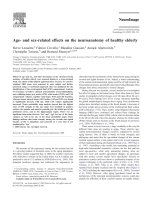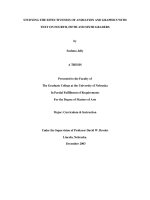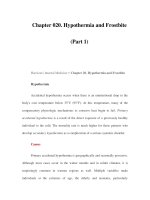Playing, Laughing and Learning with Children on the Autism Spectrum - part 1 potx
Bạn đang xem bản rút gọn của tài liệu. Xem và tải ngay bản đầy đủ của tài liệu tại đây (178.59 KB, 25 trang )
Playing, Laughing and Learning with
Children on the Autism Spectrum
of related interest
My Social Story Book
Carol Gray and Abbie Leigh White
Illustrated by Sean McAndrew
ISBN 1 85302 950 5
Relationship Development Intervention with Young Children
Social and Emotional Development Activities for Asperger Syndrome, Autism, PDD
and NLD
Steven E. Gutstein and Rachelle K. Sheely
ISBN 1 84310 714 7
Caring for a Child with Autism
A Practical Guide for Parents
Martine Ives and Nell Munro, National Autistic Society
ISBN 1 85302 996 3
Asperger’s Syndrome
A Guide for Parents and Professionals
Tony Attwood
Foreword by Lorna Wing
ISBN 1 85302 577 1
Autism and Play
Jannik Beyer and Lone Gammeltoft
ISBN 1 85302 845 2
Giggle Time – Establishing the Social Connection
A Program to Develop the Communication Skills of Children with Autism
Susan Aud Sonders
ISBN 1 84310 716 3
Playing, Laughing
and Learning with Children
on the Autism Spectrum
A Practical Resource of Play Ideas
for Parents and Carers
Julia Moor
Jessica Kingsley Publishers
London and New York
All rights reserved. No part of this publication may be reproduced in any material form
(including photocopying or storing it in any medium by electronic means and whether
or not transiently or incidentally to some other use of this publication) without the
written permission of the copyright owner except in accordance with the provisions of
the Copyright, Designs and Patents Act 1988 or under the terms of a licence issued by
the Copyright Licensing Agency Ltd, 90 Tottenham Court Road, London, England
W1P 9HE. Applications for the copyright owner’s written permission to reproduce any
part of this publication should be addressed to the publisher.
Warning: The doing of an unauthorised act in relation to a copyright work may result
in both a civil claim for damages and criminal prosecution.
The right of Julia Moor to be identified as author of this work has been asserted by her
in accordance with the Copyright, Designs and Patents Act 1988
First published in the United Kingdom in 2002
by Jessica Kingsley Publishers Ltd
116 Pentonville Road
London N1 9JB, England
and
29 West 35th Street, 10th fl.
New York, NY 10001-2299, USA
www.jkp.com
Copyright © Julia Moor 2002
Second impression 2003
Library of Congress Cataloging in Publication Data
Moor, Julia, 1966–
Playing, laughing, and learning with children on the autism spectrum:apractical
resource of play ideas for parents and carers / Julia Moor.
p. Cm.
Includes bibliographical references and index.
ISBN 1-84310-060-6 (alk paper)
1. Autistic children Treatment. 2. Autism in children Treatment. 3. Play therapy. 4.
Parent and child. I. Title.
RJ506.A9 M66 2002
6168.92’8982065153 dc21
2002021521
British Library Cataloguing in Publication Data
A CIP catalogue record for this book is available from the British Library
ISBN 1 84310 060 6
Printed and Bound in Great Britain by
Athenaeum Press, Gateshead, Tyne and Wear
Contents
Acknowledgements 10
Introduction 13
1. Why is Playing So Important? 17
Why is play so difficult for children with autism?
So what do we actually mean by play?
2. Early Playing Skills: Gaining Attention
and Sharing Space 21
What does ‘sharing space’ mean?
The drive to avoid
Communication
Ideas to try
Moving on
Individual example: Andrew
3. Structured Play 33
Why do children on the autism spectrum need structure?
What does structuring play actually mean
and how does it work?
Creating play opportunity – setting the stage
Breaking play down into tasks
Applied Behavioural Analysis (ABA)
Structuring early learning
Individual example: Sam
Structuring the day – creating a visual diary
Introducing choice and flexibility
4. Toys, Toys, Toys 49
Help – my child won’t play with his toys!
Reassessing existing toys: back to basics
Being organized
Picture prompts for playing
Getting started: ideas
Individual example: Sally
Sources of toys
What to look for in appropriate toys
Separating toys into challengers and reinforcers
Modifying existing toys to remove stress
The importance of realism
Specific useful toys
Birthdays and Christmas
5. Table-Top Games and Puzzles 69
What is a puzzle?
Getting started
Shapes
Introducing fun into table-top play
Colours
Matching games
Posting games
Simple jigsaws
Bricks
Threading
Categories
Memory games
6. Music 89
Saviour and enemy
Ideas to try at home
Finding a collection of enjoyable pieces
Listening and playing to music together
Relaxation
Scripts to rhythm – encouraging speech through song
How does this work in practice? – ideas
Singing spontaneous commentaries
Making your own music
Using your music box
Auditory Integration Training
7. Turn-Taking in Play 109
Theory of mind and social development
Why is turn taking difficult for children on
the autism spectrum?
Awareness of others – practical activities to help
Awareness of others’ thoughts – practical activities to help
Small beginnings – turn-taking with an adult
Turn-taking with peers and siblings
Aids to help turn-taking
Turn-taking in everyday life
8. Physical Games and Activities 123
Sensory integration problems
Getting started
Ball games
Small ball play
Large hoop
Indoor ball pit
Large boxes
Making a tactile box
Imaginative uses for boxes
Human ‘jack in the box’
Puppet Theatre
Trampoline
Indoor slide and balance beam
Cushions
Skittles
Other useful physical play toys
9. Outdoor Play 141
Problems and solutions
Safety
The benefits of outdoor play
The need for structure
Getting started: games and activities
Pavement chalking
Throwing balls at targets
Sand play
Messy art
Balance and co-ordination games
Balance beams
Outdoor adult role-play
Picnics
Big outdoor play equipment
Tunnels, play tents and cubes
Outdoor play in winter weather
10. Water Play 165
Autism and water
Problems and solutions
Individual example: Katherine
Enjoying water play indoors
Bath time play
Table top water play
Outdoor water play
Swimming
11. Television Potential 177
Television – why?
Common problems and possible solutions
Many uses for the camcorder
Video modelling
12. Being Creative – Art and Craft 187
Why art?
The obstacles between art and your child
Gaining attention by being indirect
Getting started
Art ideas
Scissors and glue
Craft
13. Creating Imaginative Play Sequences 203
What type of toys?
Simplicity
Realism
Familiarity
The right environment
Getting started
Building scripts
Individual example: Jonathon
Moving on
In summary
More suggestions
I can’t draw!
Problems
This seems like so much effort!
14. Introducing Books and Reading 219
The problems
Starting out – looking at books together
Individual example: Peter
Individual example: Fay
Ideas
Moving on – reading for meaning
Problems with reading for meaning
Story sequences and consequences
Goals
Observation, timing, preparation
Specific books to try
Popular characters
Tape/book packages
Early literacy
Word recognition
Individual example: Lewis
Activities to develop language understanding
Finally
15. Problems, Frustration and Tantrums – Making
Play Enjoyable 249
Deal with your own frustration first!
Reducing stress while you play
Flexible parenting for rigid kids!
Re-assessing play skills – the need for goals
Enjoy your child
Resources
BIBLIOGRAPHY 261
THERAPEUTIC OPTIONS/ORGANISATIONS 263
RECOMMENDED READING 267
WEBSITES FOR ARTICLES WRITTEN BY ADULTS WITH AUTISM 267
TOYS AND SUPPLIERS 269
PICTURE PROMPTS TO COPY AND USE 275
INDEX 279
To my husband Chris, for his loving
support and dedication and for being
with me on the journey every step of
the way.
11
was missing a vital part of his childhood and watching his mean
-
ingless rituals and being constantly shut out were breaking my
heart.
For 12 months my main focus had been getting through the
day without distress, but I wanted more than this for my son and
felt angry with the autism for robbing him of what I felt was his
birthright. It seemed that so many things were off limits; his world
(and mine) was getting smaller and smaller; at an age when curios
-
ity was meant to urge him forward – to explore, to communicate,
to experience and understand his world – my son simply wanted
to shut it out. Frustratingly for me I knew that there was vast
potential; an able, intelligent little boy held hostage by the differ-
ent way in which his brain thinks and processes.
As someone who likes to feel there is a practical solution to
everything, I decided to haul myself out of the pit of ‘why us?’ and
to really try to understand first, his disorder and second, how he as
an individual expressed his autism. Armed with this information I
knew there’d be no miracles but at least I’d be making informed
choices and be doing everything in my power to shorten the
distance between his world and mine. On top of this I just felt I
had to find a constructive way to fill what seemed to be an eternity
of weeks and months with a little boy that simply didn’t want to
engage with the planet he was born on. I didn’t know him.
I began to realize that the direct ‘front door’ approach to inter
-
action was useless: “look at this”, “Let’s do this” “Come here and
see” – they were cues for him to protest or run off and avoid inter
-
action; fight or flight. Instinctively I felt there must be other
pathways to access my son, and what I found through trial and
error was that there was indeed a ‘back door’ where I could sneak
in and capture his attention without him even realizing that was
what I was doing!
14 Playing, Laughing and Learning with Children on the Autism Spectrum
Gradually over two years we built up a repertoire of play, trans
-
ferring similar indirect techniques from one activity to the next,
building on success and learning from failure. I discovered how to
improve communication, how to structure not only the day as a
series of activities but activities as a series of tasks. I also found I
could punctuate the day with short bursts of direct learning toler
-
ated by the prospect of a variety of motivational strategies.
It dawned on me through talking to and reading about other
parents that they too had similar methods. After surveying a
hundred such parents it became apparent that there were ideas out
there but that there was also desperation for more. Our children
are very individual; they deal with their autism in unique ways and
are affected to different degrees with varying associated learning
difficulties. Yet there are so many common threads: a need for
routine and visual cues, problems with sensory overload, and a
natural motivation to avoid anything outside the repertoire of
familiarity.
Four years ago I needed a book of ideas; something that related
to my son’s specific collection of problems. Everything I assumed
about parenting – providing love, attention and a stimulating
environment – was rewritten by his diagnosis. It stripped me of my
confidence as a mum. I questioned common sense because even
that often didn’t work. Yet this book is about common sense.
Mums and dads are in a prime position to help their children reach
their fullest potential. Parents come armed with unconditional
love, an unsurpassed knowledge of their individual child and the
motivation and commitment to do ‘whatever it takes’. I hope this
book will not only provide you with a collection of useful ideas
but will help you find a way of playing with your child that
rebuilds confidence and relationships. The ideas are there to dip in
and try. Some may work, some may not – they do not constitute a
task list that has to be ticked off and worked through! Choose
Introduction 15
those that you feel your child is ready to tackle, and that you are
confident trying; leave the rest for weeks, months or even years
later.
Our children’s development doesn’t correspond to a set of ages
and stages and as such there are no age guidelines. Keep moving
forward by carefully monitoring what your child is capable of and
ready to tackle next – but don’t rush, push or pitch your expecta
-
tions in advance of his ability. More fundamentally, the point is to
illustrate that by really observing and understanding your child you
can learn to tune into his most receptive moments, to tailor the
environment to increase these opportunities and to interact with
him in a manner that prolongs them.
So what qualifies me to put these ideas together? It isn’t my
recent degree in psychology or my eight years working with
adults with learning disabilities (many of whom have autism); it is
being a mum to a little boy who has challenged me all his waking
(and sleeping!) hours, day in and day out, to understand the way
his brain works and the way he as an individual thinks, and to use
this information to help him play, both independently, and to
engage with me in a variety of shared activities. I would not dare to
portray myself as an expert on autism, but living with and loving a
child with autism is an incredible journey of learning and
re-evaluating what we expect from parenthood. As parents we
often feel helpless when our children are first diagnosed – yet as
parents we are in the best possible position to help.
Please note that the individual examples in the book are illus
-
trations based on the types of experience reported back to me in
the surveys and on my own experience. I’ve used the male gender
throughout – this is simply to make reading easier and less formal.
Throughout the book there are several comparisons to
‘non-autistic’ children. I prefer this term to the ambiguous word
‘normal’.
16 Playing, Laughing and Learning with Children on the Autism Spectrum
•
test how material objects work and how actions can
change outcomes, for example ‘If I lift this ramp up, the
toy car slides down’ or ‘What happens if I pour water
from this beaker into this little cup?’
•
try out frightening ideas safely, for example ‘The bad
wolf is hiding and he’s going to get me if I make a
noise…’
•
work out the relations between people and how to
behave and what to expect in certain situations, for
example playing doctors, families, teachers
•
express imagination and creativity through music,
dancing, drawing, playdough etc., giving the child a
sense of esteem and pride in his achievements
•
re-enact everyday situations using toys and apply
different storylines and consequences for example
‘Mummy and little girl are out walking, oh no little girl
has fallen…lets get a plaster…’ or ‘…call an
ambulance…’or ‘… kiss it better…’ etc.
This list of why play is important is not definitive and obviously
the child is completely unaware as to why he is playing – he just
wants to. Instinctively he is motivated to initiate interaction with
people and with his environment, and the nice feeling he gets
from doing it stimulates him to keep doing it.
Why is play so difficult for children with autism?
First look at the problems common (in varying degrees) to all
children on the autism spectrum:
•
Language problems both in expressing and
understanding the content of speech.
18 Playing, Laughing and Learning with Children on the Autism Spectrum
•
Problems with social interaction – an unwillingness to
allow others to share experiences, a lack of
understanding of the thoughts and feelings and
intentions of others and a general problem with the
interpretation of non-verbal cues: facial expressions,
tone of voice etc.
•
Problems of imagination – difficulty in grasping the
meaning of imaginary situations, often leading to
repetitive, obsessive actions that only mean something
to the child himself.
Given that each of the above is an essential ingredient that allows
children to play, it’s no wonder the child with autism feels lost and
confused and resorts to activities that are meaningful and comfort-
ing only to him, even if they are repetitive and inappropriate.
So what do we actually mean by play?
The first thing that springs to mind when we mention play is the
use of toys. This can be misleading – abandon a non-autistic
three-year-old in a room filled with unfamiliar toys and he will flit
from one to the other, not really knowing what to do with them;
he needs interaction with an adult – to be shown and helped so
that later he can share the experience with another child. Often
the interaction is more rewarding to the child than the toy itself;
he delights in the adult’s delight at an object. In fact the adult’s
reactions teach him how to react, which he can then generalize to
a new type of a familiar toy.
The key to playing is therefore interaction. ‘But this is so diffi
-
cult with my youngster’, I hear you say. It certainly is, especially if
your child simply doesn’t understand that communication ‘means’
anything. The extent and quality of your interactions will differ
according to your individual child’s level of disability but the
Why is Playing So Important? 19
effort (and you will need lots of it!) will be rewarding both to you
and your child as you begin to build structures for learning and
communicating in the future. Toys are tools or props to aid inter
-
action through play, often the minimum or even no props are
needed; a box, a cushion, a ball or you may adapt a game/toy that
you already have.
Putting these ideas together hopefully illustrates that although
teaching your child how to behave and respond in certain situations
is useful, developing in him a real sense of enjoyment in interac
-
tion will further motivate him to seek out interaction (probably
against the better judgement of his autistic brain) and allow him to
socially develop to the best of his potential.
Using this book
Try to read Chapters 2, 3 and 4 to start off with. These chapters
look at the general principles of using indirect non-confron-
tational play approaches with short bursts of structured directed
play. They give you ideas of how to set about finding different
pathways to access your child’s attention and how to create oppor-
tunities for him to interact and communicate, as well as tackling
the practicalities of using and organizing the play equipment you
already have. The rest of the chapters look at specific areas of play
and are filled with practical ideas for how to approach them and
maximise interaction opportunities and learning potential. Not all
the play ideas will be appropriate for your child. Some are pitched
at ‘difficult to reach’ children who may have additional learning
difficulties; others are suitable for verbal, able children needing
on-going activities. Choose those suited to your child and the areas
that you feel need to be worked on.
20 Playing, Laughing and Learning with Children on the Autism Spectrum
benefits that communication brings or indeed learning that com
-
munication actually ‘means’ something to them. Through deliber
-
ate attempts to encourage your child to fleetingly share his atten
-
tion you can move beyond his initial aversion to show him that
communication is actually a good thing. Being able to communi
-
cate (in which ever way he can) will enable him to express his
needs and emotions and understand the people and world around
him in a way that can actually lessen his anxiety in the long run.
Always be aware of the anxiety and discomfort that direct
approaches to interact with your child may be causing. Let your
understanding of these feelings be reflected in gentle
non-invasive interactions and where a direct approach is used,
keep it to short comfortable bursts.
How do you try to ‘share space’ with a child with autism?
Before you can attempt to interact with your child at a level that
might be called joint play, you need to bring about a realization in
him that no matter how uncomfortable the feelings are, to share
your space even for a few seconds is such fun and brings such
benefits that it can override his drive to shut you out.
When parents become aware that their child has a reluctance to
allow them into their ‘space’, (often noticeable around the age of
12–18 months, when we expect them to enjoy joint attention), we
typically attempt the usual routes: making our voices extremely
enthusiastic, physically pulling the child back towards us, talking
louder (in case of a hearing problem) and usually resorting to the
idea that ‘maybe he just wants to be on his own again’. Along the
way some things might work, so thankfully we keep them up –
rough and tumble, tickling, singing – they all seem to fleetingly
bring about a response, but usually there is no method or structure
to what we are doing. If you are lucky enough to have an early
22 Playing, Laughing and Learning with Children on the Autism Spectrum
diagnosis then the deeper understanding as to why your child
behaves this way may help – but where do you start?
Communication
How do you create a motivation to communicate?
Observe when your child is most accessible and jot down when
these times are. It may be:
•
when he’s being tickled
•
when you sing to him
•
when you play rough and tumble
•
when he’s eating something he really likes
•
when he’s jumping on the trampoline
•
when he’s splashing in puddles
•
when he’s having a bath
•
when he’s relaxed and in bed.
It may be none of the above but something else, a time when he
seems receptive, relaxed and willing to look at you (no matter how
fleetingly). It may even be a time that you hadn’t noticed before,
such as sitting in the car (ride as a passenger next to him one day
and watch his reactions to you), or swinging in the park.
Once you have pinpointed these times, use them as periods
when you really work on showing your child that communication
with people means something – that it brings its own rewards.
J Encourage your child to touch you and create a response
that he may find appealing. For example, guide his hand to
your face and make a ‘beep beep’ noise when he touches your
nose, or put out your tongue. Make the same response every
time so that he realizes that the same gesture creates the same
response. He may want to repeat the game over and over.
Early Playing Skills: Gaining Attention and Sharing Space 23
When he gets the hang of it, make a new gesture for touching
different parts of your face. Touch his face and encourage him
to make the noise with you. This may be a good game to play
last thing at night when he’s lying in bed, or when he’s in the
bath.
J When you are engaging in a game he enjoys, such as
tickling, stop to take a long pause (often longer than you might
feel comfortable with), and wait for your child to make a
gesture to indicate he wants the game to continue; this may be
by making eye contact or pulling your hands back to him. In
response, look back at your child, and say, ‘You want more? –
yes?’ and carry on the game.
J ‘Peek-a-boo’ games – Hold a cushion/cloth up to your face
or hide behind objects (a huge box or play tunnel is great).
Create lengthy pauses to build up anticipation and to give your
child a space to indicate that he wants the game to continue.
J Pulling silly faces – Cover your face with your hands and
as you take them away change your expression. Try wearing a
hat or painting your nose red with lipstick so your child really
looks into your face. Encourage eye contact before you change
expression.
J Dancing – Swing and sway to music with your child, then
stop and pause for him to indicate he wants more. (See Chapter
6 for lots of dance / music activities.)
J Blowing raspberries onto the palms of his hands/tummy
– wait for eye contact before you do it again.
Allow your child to dictate how long he lets you into his space – I
found that the moment I attempted to prolong an activity and
force my attention on my son, then that particular activity ceased
to have an appeal to him.
24 Playing, Laughing and Learning with Children on the Autism Spectrum
Once you are familiar with how your child responds when he
attempts to communicate, look for more and more ways to access
him and more opportunities for him to interact.
Ideas to try:
J Balloons – Simple and often effective, try letting a
blown-up balloon deflate and whiz around the room. Let your
child anticipate when this will be by saying ‘ready, steady –
go!’ Leave a pause before you let go of the balloon so that your
child can anticipate the activity and be motivated to either
attempt to say ‘go’ or make a gesture to communicate it to you
such as making eye contact. Novelty shops often sell items
powered by balloons, for example, cars that move along the
floor or helicopters. These types of shops are not marketed
towards very young children but are worth a visit for novelty
items that your child would find difficult to ignore. Never
leave such things where your child might get hold of them on
his own as they may not be safe or have small parts that he may
choke on – supervised play only! Try patting a blown-up
balloon at your child; if he likes a particular object, draw it
onto the surface (or stick a picture of it on the ballon).
J Bubbles – There’s a multitude of different bubble-
blowing machines/wands available. Don’t forget to wait for
your child to make eye contact before you blow more bubbles.
If your child wants to blow them too, choose something easy
for him to handle (special no-spill containers are also
available). If you are initially introducing bubbles to access
your child’s attention and build motivation to communicate
it’s best to control the bubble-blowing yourself otherwise the
game could soon dissolve into a solitary activity. However,
later on, you may wish to use bubbles as a rewarding activity
for attempting something more demanding. Encouraging
your child to blow is good exercise for those speech muscles or
Early Playing Skills: Gaining Attention and Sharing Space 25
if he’s having difficulty blowing himself, try one of the little
battery-operated fan/bubble-blowers for instant impact (and
easy for him to use too). Also try the bubble wands with
built-in fans/whistles. Watch out for the bottle of solution
being more interesting than the bubbles! If your child likes
containers of this type keep them out of sight and just hand
him the wand. Avoid worrying about the carpet by putting
towels on the floor so your attention isn’t diverted and you can
really have fun. (For suppliers of bubble activities, see the back
of the book.)
J Feathers – Some children with autism find the soft touch
of a feather very uncomfortable; others (like my son) find it fun
to be tickled by it, and to use it to tickle me! Try the really big,
brightly coloured plumes you find in sewing and craft shops.
Don’t just launch at your child with it – play at tickling
teddy/siblings/yourself until he starts to take notice and
gently try it out on him, leaving long pauses to build up his
anticipation.
Remember to make it easy for your child to establish eye contact.
Get on your knees at eye level or even underneath your child’s eye
level. Don’t make him have to look up at you.
J Share your child’s chosen activity. If he runs about the
room making noises, copy him! Act as if his behaviour is
purposeful and meaningful. After you have imitated him for a
while, pause and wait for a reaction. Leave plenty of spaces for
him to react if he wants. Try introducing some variations of
your own and encourage him to imitate you.
J If he is holding a toy, act as if he is showing it to you.
Hold it up (though don’t necessarily take it out of his hands)
and talk about it.
26 Playing, Laughing and Learning with Children on the Autism Spectrum
J Jack-in-the-box-type toys – These ‘now you see them, now
you don’t’-type toys are often aimed at babies but have the
appeal of instant reward and increase motivation by building
anticipation. My son loved the ‘frog in a box’ toy (by Galt – see
references at the back of the book.)
J Attention Grabbers Box – For sheer practicality, try putting
together a box of props you and others can use. I often came
across silly novelties that looked like they had potential –
some worked, some didn’t, but eventually I had a box of little
secret weapons. I kept this out of my son’s reach. It wasn’t an
all-purpose toy box. In it was a collection of things which
included:
°
a spinning top
°
a feather
°
a glove puppet
°
a bubble machine
°
a party blower
°
a yoyo
°
a sticky ball (you threw it against a wall and it slid
down slowly!)
°
some Sellotape (my son loved the sound)
°
a magnetic spinning dolphin.
You might try holding up two items and encouraging your child to
point to which he wants – physically mould his hand into a point
shape if necessary. Throughout the day encourage this when he
goes to grab something, mould his hand into a point and then
touch the item before giving him it. Reinforce the gesture by
saying, ‘Point to…[whatever it is he is requesting].’
Early Playing Skills: Gaining Attention and Sharing Space 27
NOTE: Always be wary of including something your child
likes to the point of obsession otherwise this becomes more
important than you or the interaction!
Moving on
When you have found a number of ways to access your child’s
attention for a few seconds, use these to associate them with
another activity, in order to prolong the moment. What you are
doing is using something your child finds highly pleasant (for
example tickling) and making him associate that with something
he probably wouldn’t respond to originally – for example, any
one of the following:
J Singing a commentary.
J Saying a commentary to a drum beat.
J Using a special hand action rhyme.
J Stroking faces and labelling eyes, nose etc…
J Playing ‘Horsey Horsey’ – try a more sedate style than
rough and tumble, the focus being on the song.
The case below illustrates how this might be done.
Individual Example: Andrew
Three-year-old Andrew loved to be tickled and his parents
loved to tickle him. During this time he squealed with
delight, he looked into their faces, he allowed them to touch
him – he was ‘with them’. When the activity stopped,
Andrew ‘disappeared’ again. It was desperately frustrating
for his parents to know that he could enjoy sharing space but
that this was limited simply to being tickled. They had no
28 Playing, Laughing and Learning with Children on the Autism Spectrum









